Exploration and Discovery in The Legend of Zelda: Breath of the Wild
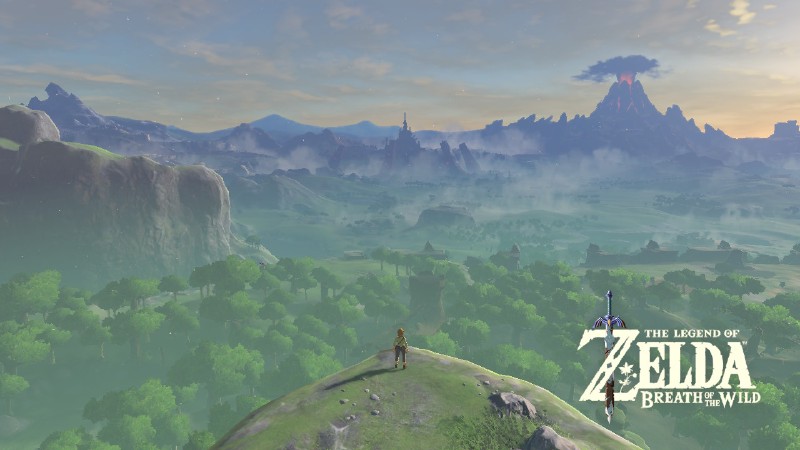
I recently finished the latest game in the The Legend Of Zelda series, Breath Of The Wild, on the Nintendo Switch. While playing Breath Of The Wild, I noticed many Game Design elements that I encountered in other recent open world games too, like towers that reveal parts of the map, the combination of sandbox and linear storytelling and the nature of space in the game world itself. Breath Of The Wild’s game world and design is surely inspired by games from the long-running Assassins Creed series and other Ubisoft open world titles like Far Cry, but Breath Of The Wild’s both simple and engaging game world made it feel especially hard to put down compared to other modern open world games. In this post I argue that Breath Of The Wild exhibits game design elements that cleverly put exploration and discovery first in the open world, an engaging way of storytelling that no game before it compares to.
Many of the game design elements discussed here are introduced in the game’s starting area. Breath Of The Wild begins with a short cutscene, followed by Link leaving the Shrine of Resurrection to find himself on the Great Plateau, an area in the south part of Hyrule, the game world. This plateau, the “birthplace of the entire kingdom of Hyrule,” overlooks large areas of the game world that Link will encounter later in the game. Distinct landscape features and man-made structures can be seen from here like the Temple Of Time, Death Mountain volcano or Hyrule Castle, the player’s ultimate destination, which is framed in the very center of the title shot. The notion that the player can go anywhere she or he can look from here is just hinted at. As a first objective after talking to an NPC, Link has to head to the Temple Of Time. This early objective is not depicted by a mission marker as an UI element nor as an element on the map. The importance of the Temple Of Time is expressed both visually through its height in the game world and verbally through the description of the NPC. While this clearly points the player to the next quest step, the player is still trusted to figure out where to go on her or his own. The need for an orientation skill and being present in the game world in order to advance is foreshadowed. The player is not simply asked to follow a blinking arrow pointing at the way to go, like many other open world games do.
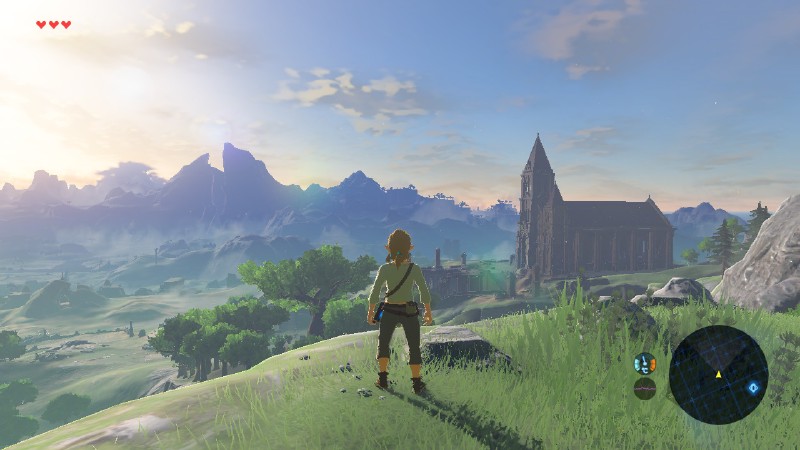
The (Not So) Free Open World
In Breath Of The Wild, Hyrule feels very open and the player is free to go everywhere on the map after leaving the introduction area. Technically, there are no artificially gated-off areas in the game world. In the narrative, there are four main quest lines that need to be completed before the end of the game. Each quest line plays in a different area of the map and ends with Link taking over a divine beast by solving puzzles in an elaborate dungeon and defeating a boss. These four quest lines can be completed in any order, so many players’ passage through the game will be different from each other. But how is difficulty addressed when the order of events in the game can be so varied? As a reddit user found out, enemies’ power and strength scale with the amount of enemies the player killed over the course of the playthrough. This helps to give the game an ascending difficulty curve while the player has some freedom in choosing the order of comleting quests.
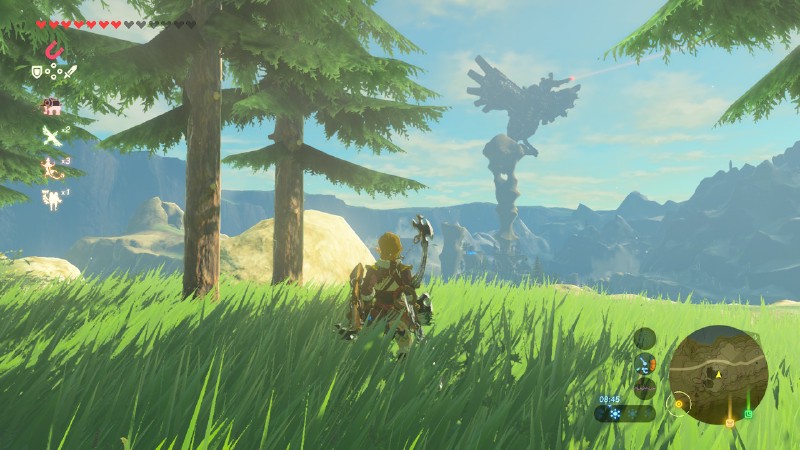
The aforementioned freedom of traversal in Breath Of The Wilds’s open world is limited in some ways. Link’s stats, which increase over the course of the game, can restrict the player’s ability to move freely in Hyrule. Stamina limits climbing, swimming and the use of the paraglider, and Link’s HP level makes fighting strong enemies very hard. Armor and weapon stats only increase over the course of the game, making certain areas naturally hard to reach early in a playthrough. The open world in Breath Of The Wild has a lot of vertical space, both in the natural environment with its mountains, valleys, cliffs and waterfalls and in its artificial structures like towers and high buildings. When Link’s stamina level is too low, these structures can block off whole areas to the player, because Link just can’t climb high enough, swim long enough or fly far enough to reach certain points. There are some movement abilities that Link gains after completing certain quest lines, like swimming up waterfalls, which further opens up traversal options.
Areas that are hard to get into when a player first encounters them are put on a mental to-do list, and when a player comes back to such an area with high enough stamina, HP and more powerful gear, the sense of accomplishment when finally making it into a previously blocked off area is great. Additionally, this gives the player a meaningful reason to upgrade Link’s stats with spirit orbs and more powerful gear.
Towers that reveal map
The Great Plateau area houses a Sheikah tower, a main mechanic in exploring the game world. When climbed and activated, the part of the map surrounding the tower is revealed. When a player enters a new area, these towers are often the first destination. This is introduced through the tower being one of the first objectives in the introduction area. Towers do not only reveal parts of the map but also function as high vantage points that overlook the surrounding area. This game design element is prevalent in modern open world games like the Assassins Creed series, the Far Cry games or the latest Spider-Man game. In these games, towers additionally reveal mission marker and objective icons on the map.
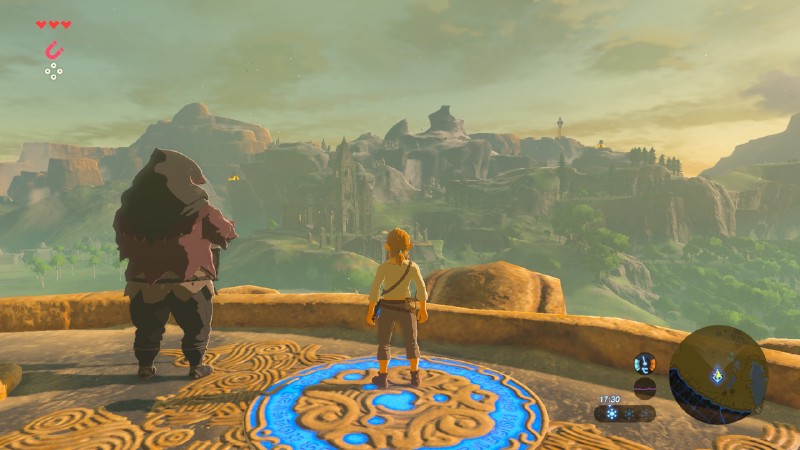
Breath Of The Wild handles the tower mechanic differently. While going to the top of the tower and activating it reveals the area around the tower on the map, no quest or objective markers are revealed. Instead, the player is encouraged to find visual clues for what to do next from this high vantage point. A scope can be used to get the surroundings closer to the player. But how does the game present interesting location for the player to discover? First, prominent landscape features like the Death Mountain volcano or the Dueling Peaks mountains stand out and are often surrounded by relevant locations like towers, shrines and staples or are the location for main quest lines. Second, shrines and towers have an orange glow that stands out against the mostly blue, gray and lush green valleys, grasslands, forests and mountains in the game world. All colors are washed out in the distance, a stylistic device that can be found too in the famous oil painting “Der Wanderer über dem Nebelmeer.”
Exploration as a Core Game Mechanic
In Breath Of The Wild, the exploration of the open world is a core game mechanic. With the overarching objective of the game established in the first hours of the game (the defeat of Calamity Ganon at Hyrule Castle), quest lines have to be discovered by the player to be initiated. There is no set order of main and side quests the player has to follow. This leads to an active relationship between space in the game world and the player, because the game world is not just a passive piece where events take place but a way for a player to advance the story through exploration and discovery. One way that Breath Of The Wild encourages the player to explore the game world is the absence of a GPS or path-finding system for showing the way to an objective, neither as an overlay on the screen (compass or mini map) nor as an element that arguments the game world itself. When such an element is present in an open world game, it encourages the player to just bluntly follow a compass indicator or line on a mini map which takes player attention away from the game world space itself. Many open world games before Breath Of The Wild like the Assassins Creed games or the GTA series have multiple objective markers on the in-game map that show all available main and side-quests. This basically transforms the (mini-)map to a glorified to-do list, where the player can simply tick of quest after quest to complete an area. When selecting an objective marker and getting there by following a compass indicator, the spatial element of the game world is reduced to a simple traversal problem of how to get to this point the fastest. This can be fun when moving around the game world itself feels satisfying like swinging around Manhattan in Spider-Man or jumping over the roofs of Florence in Assassins Creed, but ultimately the game world is not an active part in the player’s narrative but just a way of getting to the next objective. Collectible items that are technically needed to 100% a game are sometimes the only way many open world games still embrace exploration of the game world space. Breath Of The Wild does not show markers of available objectives on the in-game map. Quests have to found in the game world to be initiated, and many side quests’ objectives do not pinpoint a location on the map where the player can advance the quest, rather, vague verbal instructions are given that encourage the player to walk around and solve problems spatially in the game world. An example for this is a side quest in the Geruo Town area asking the player to “solve all the town’s problems” in order to obtain a powerful armor item. This can only be achieved when the player actually explores the area and finds all NPCs that need help.
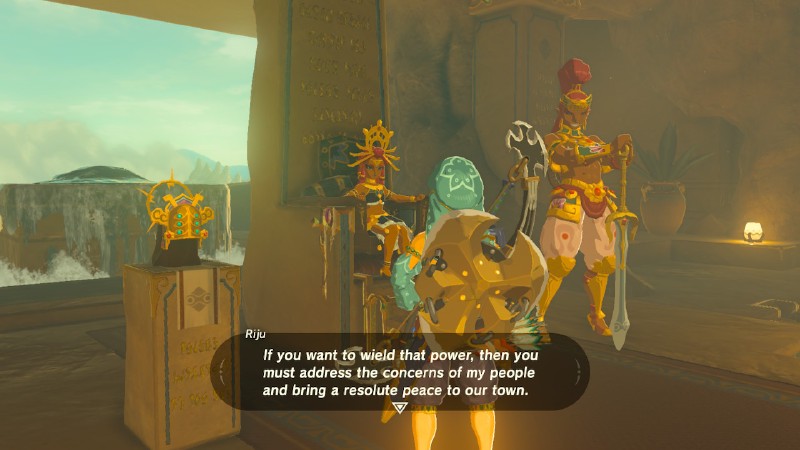
The task of completing an open world game by finishing all main and side quests is tangible when all available quests of a given area are shown as markers on the map. Some open world games even provide maps to collectible items. This is a more transparent way a game presents objectives and quests, a contrast to the dynamic and organic way storytelling works in Breath Of The Wild. Ernest Adams calls this “Sandbox Storytelling,” where plot is advanced not through movement through space but by other means. Order of completion is not relevant and “travel is an integral part of the experience.” (The Designer’s Notebook: Sandbox Storytelling) He identifies several sandbox stories that can be told in big open worlds. Breath Of The Wild exhibits some of these storytelling devices, like the “Find the buried treasure,” “Find People” and “Infiltrate” stories, but the main overarching plot is ultimately still told in a linear fashion, only broken up by the player’s freedom to choose the order of completing the four Divine Beast quest lines. The way to find those objectives by exploration is truly dynamic though, guided by what Chris Bateman calls “funneling” (Game Writing: Narrative Skills for Videogames), which are “various tricks for helping the player find the ‘spine’ of the game.” (Adams) Some of the funneling techniques in Breath Of The Wild include carefully constructed sight lines from vantage points (towers) that allow the player to find important locations, which are often of contrasting color to the background. When looking at the core game loop of Breath Of The Wild, exploring the world space stands out as an important part. After capturing a tower, the player can survey the surrounding area from the high vantage point and mark interesting locations with markers through the scope. The main markers, which appear in the game world itself as light columns when looked at through the scope, are limited in number. This encourages the player to mark out a set of the next things to do, creating a game loop that is managable in the short term.
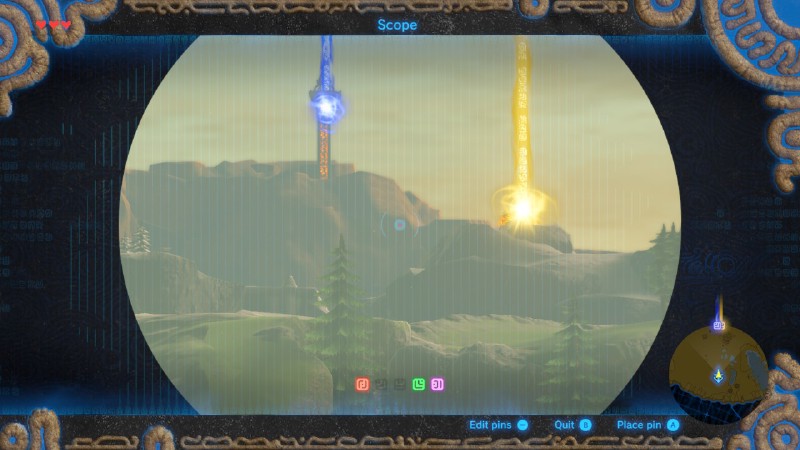
One side objective is to help Link remember memories about earlier years of Hyrule by finding the specific locations where these memories formed. As a hint, the player is presented with an image of the game world that was taken from that location. An NPC can give the player additional hints like landscape features relative to the unknown location. These almost puzzle-like objective can only work well in a game world that has diverse space where areas are clearly distinguishable from each other and prominent and unique landscape features can point to specific locations.
Is Hyrule Empty?
Breath Of The Wild has a large open world space which at first glance can seem emtpty. Between a handful of small populated areas there are vast plains, mountains and valleys. Other recent open world games like Spider-Man, GTA and Whatchdogs comprise of busy and crowded urban spaces which makes them seem much more dynamic on the surface. But at a closer look, many of the structures in these open worlds are closed off to the player. Most buildings in Spider-Man’s Manhattan or GTA V’s Los Santos are not accessible. This removes freedom from the player: There is a vast open world to explore, but artificial boundaries block the player from entering many areas. Breath Of The Wild handles this differently. Almost all structures and buildings are accessible to the player. When you see it, you can most probably explore it further. There are no artificial barriers, giving the player an integral sense of freedom. Nintendo can achieve this level of freedom because the total amount of structures and buildings that are scattered over Hyrule is relatively small. The in-between spaces connecting the populated areas of Hyrule are not just there to be the canvas for quests and missions to take place in or to be nice-to-look-at scenery for getting from mission A to mission B. In Breath Of The Wild, the journey through Hyrule is an important part of the gameplay. On the way, players can always happen upon new objectives and things to do. Discovering points of interest like shrines and towers, getting quests from NPCs that travel around Hyrule just like Link does and exploring ancient structures are all things that come to the player naturally through discovery. Journey and travel are not just means to an end like getting to the next objective but an organic and dynamic way to progress in the game. Some of this in-between space is sparse and bland, both in lack of objects, complex terrain and in color, with large stretches of terrain often having blue, grey and green textures. This blandness could be connected to the technical limitations of the Nintendo Switch console, but it also gives a contrast to the more interesting areas of Hyrule that incorporate progress-relevant locations, often accompanied by complex structures and bright colors.
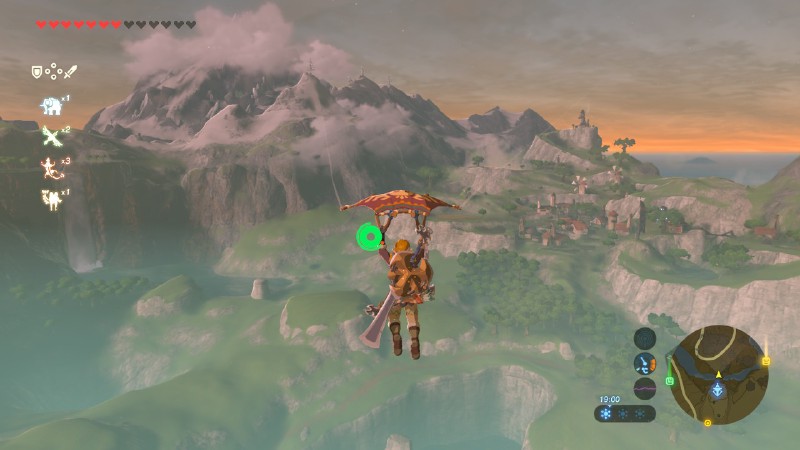
Taking the Genre Further
The Legend Of Zelda: Beath Of The Wild pushes the open world genre further than any other game in recent years. While the genre’s other pioneer series Assassins Creed tries to innovate in narrative structre, like in its latest installment Odyssey, Nintendo’s title uses the open world features to its full potential. Progression in the game is mainly initiated through exploration of the game world which makes the player’s journey in Breath Of The Wild feel dynamic and natural. Through visual queues and the design of the game world itself, the player organically happens upon things to do in the world to progress. As Eiji Aonuma, one of the creators of the Legend Of Zelda series said in an interview, the question the creators of a Zelda game ask themselves is “‘What kind of game play should we focus on?’ rather than ‘What kind of story should we write?’” (Hyrule Historia, p. 238). For Breath Of The Wild, the game’s creators very well answered the question How can we make exploring a vast 3D open world fun?